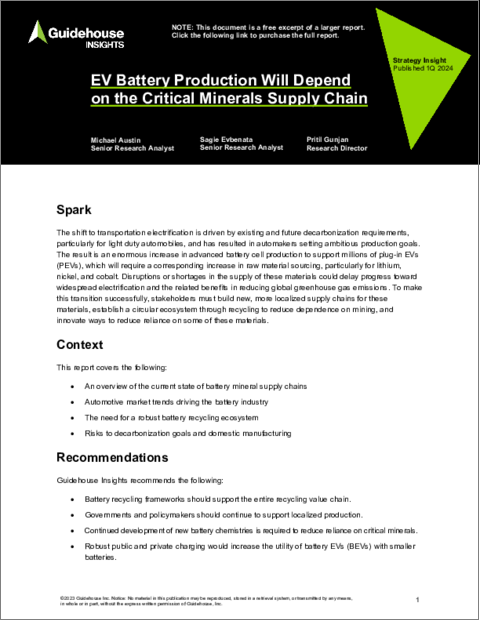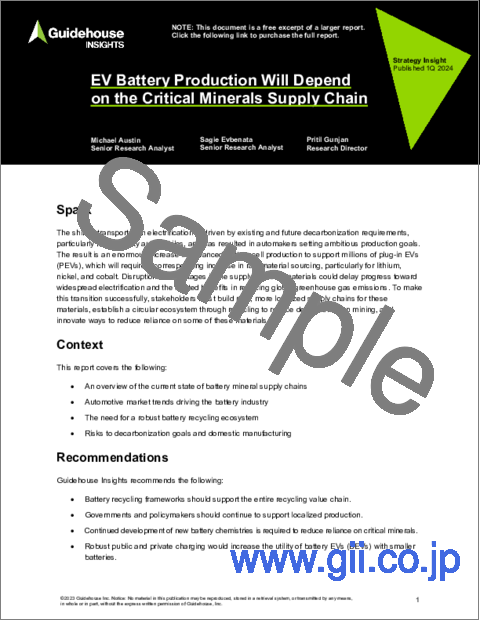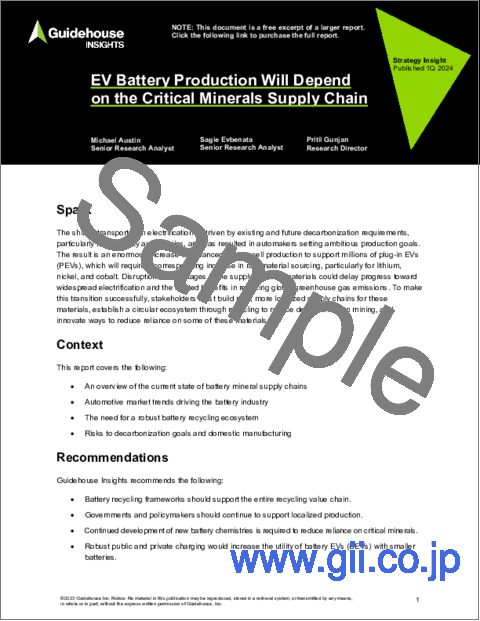|
|
市場調査レポート
商品コード
1421466
電気自動車 (EV) バッテリーの生産:重要鉱物のサプライチェーンへの依存EV Battery Production Will Depend on the Critical Minerals Supply Chain |
||||||
|
|||||||
| 電気自動車 (EV) バッテリーの生産:重要鉱物のサプライチェーンへの依存 |
|
出版日: 2024年02月06日
発行: Guidehouse Research
ページ情報: 英文 9 Pages
納期: 即納可能
|
全表示
- 概要
- 図表
- 目次
運輸の電動化シフトは、特に小型車に対する現行・将来の脱炭素化要件によって推進されており、自動車メーカーは野心的な生産目標を設定しています。その結果、何百万台ものプラグインEV (PEV) をサポートするために、高度なバッテリーセルの生産が大幅に増加しており、それに伴い、特にリチウム・ニッケル・コバルトなどの原材料調達も増加する可能性が高いです。これらの鉱物を採掘・精製するサプライチェーンは現在、特定の地域に集中しており、特に中国はほぼすべての市場で圧倒的なシェアを占めています。企業も政府も、調達先を多様化し、混乱のリスクを減らすために、供給全体を増やす努力と同時に、これらの材料の生産を増やすことを望んでいます。
このような重要鉱物の新たな供給源が確立される一方で、供給不足を含む供給の途絶は、広範な電化への進展と、それに関連する世界の温室効果ガス排出削減効果を遅らせる可能性があります。この移行を成功させるためには、利害関係者は、より地域に根ざした新たなサプライチェーンを構築し、採掘への依存を減らすためにリサイクルを通じた循環型エコシステムを確立し、一部の材料への依存を減らす方法を革新しなければなりません。
当レポートでは、バッテリー用鉱物の需要増につながる電気自動車 (EV) バッテリーの現在の需要とその促進要因について考察しています。また、バッテリー材料のサプライチェーンを多様化する動機と、サプライチェーンの混乱がもたらす潜在的な悪影響について考察しています。さらに、短期的な不足を回避して、バッテリー材料のサプライチェーンにおける長期的な持続可能性を確立するための重要な提言も行っています。
目次
- スパーク
- コンテクスト
- 推奨事項
- EVによる重要鉱物の需要増加
- 現在のサプライチェーンは地理的に集中している
- EVの増加は、バッテリーの増加と大型化を意味する
- サプライチェーンの構築には時間がかかる
- リサイクルの規模拡大には数年の時を要する
- 鉱物資源の深刻な不足により、EVの普及が妨げられる可能性
- バッテリー工場の拡張が間に合わない可能性
- 中国の自動車メーカーが従来の自動車メーカーを倒す可能性
- 輸送機械の脱炭素化の取り組みが挫折する可能性
- 自動車業界は、回復力のある循環型バッテリーサプライチェーンを構築する必要がある
- 強固なリサイクルエコシステムの確立
- 現地のサプライチェーンへのインセンティブの継続的提供
- 代替的なバッテリー用化学成員の促進
- 堅牢な充電ネットワークの確保
List of Figures
- LD BEV Advanced Battery Manufacturing by Region, World Markets: 2023-2032
The shift to transportation electrification is driven by existing and future decarbonization requirements, particularly for light duty automobiles, and has resulted in automakers setting ambitious production goals. The result is an enormous increase in advanced battery cell production to support millions of plug-in EVs (PEVs), which will require a corresponding increase in raw material sourcing, particularly for lithium, nickel, and cobalt. The current supply chains for mining and refining these minerals are heavily focused in specific geographic areas, with China having an outsized share of nearly every market. Businesses and governments alike desire to increase production of these materials concurrent with efforts to increase the overall supply to diversify their sourcing and reduce the risk of disruption.
While these new sources for critical minerals are being established, disruptions in supply, including shortages, could delay progress toward widespread electrification and the related benefits in reducing global greenhouse gas emissions. To make this transition successfully, stakeholders must build new, more localized supply chains, establish a circular ecosystem through recycling to reduce dependence on mining, and innovate ways to reduce the reliance on some of these materials.
This Guidehouse Insights Strategy Insight reviews the current demand and market drivers for EV batteries that are leading to increased demand for battery minerals. It explains the motivations for diversifying the battery material supply chain and the potential negative consequences of supply chain disruption. It also offers key recommendations for avoiding near-term shortages and establishing long-term sustainability in the battery material supply chain.
Table of Contents
Spark
Context
Recommendations
EVs Have Driven Increases in the Need for Critical Minerals
Current Supply Chains Are Concentrated Geographically
More EVs Mean More, and Bigger, Batteries
Building Supply Chains Takes Time
Recycling Will Take Years to Scale
Critical Mineral Shortages Could Short-Circuit EV Adoption
Battery Plants Might Not Scale in Time
Chinese Automakers Could Topple Legacy Automakers
Transportation Decarbonization Efforts Could Falter
The Auto Industry Must Build a Resilient, Circular Battery Supply Chain
Establish Robust Recycling Ecosystems
Continue Providing Incentives for Localized Supply Chains
Promote Alternative Battery Chemistries
Ensure Robust Charging Networks





